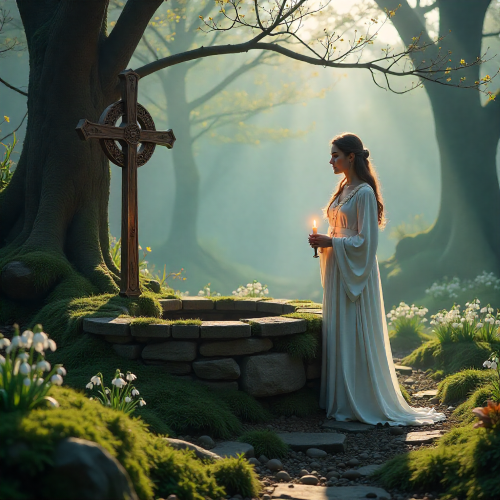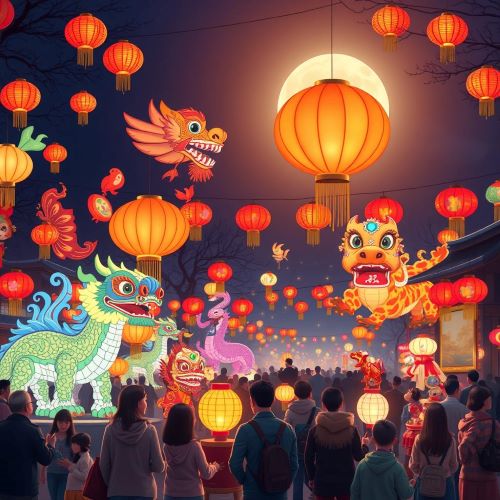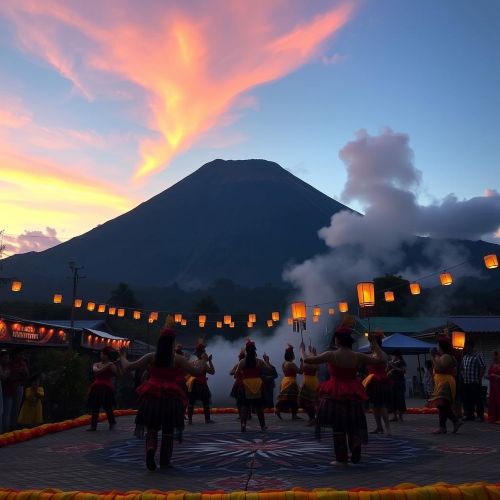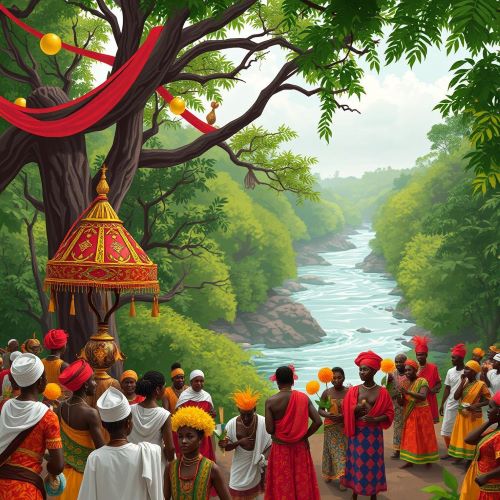
Imbolc: The Festival of Light and Renewal
At a glance
| Description | |
|---|---|
| Location | Kildare |
| Country | Ireland |
| Dedicated To | Brigid |
| Duration | 1 day |
| Time of Year | February |
Introduction
Imbolc, celebrated on February 1st, is one of the four great Gaelic seasonal festivals, along with Samhain, Beltane, and Lughnasadh. Falling midway between the winter solstice and the spring equinox, it marks the turning point when the frozen earth begins to stir with new life. The festival’s name is believed to derive from the Old Irish Oimelc, meaning “ewe’s milk,” symbolizing the lambing season and fertility of livestock. In ancient times, Imbolc represented the reawakening of nature and the return of the sun, a promise that the cold grip of winter was nearing its end. Deeply rooted in the agrarian and spiritual rhythms of Celtic life, it served as both a sacred and practical observance of seasonal transition.
Connection with Mythology
Imbolc is inseparable from the goddess Brigid, one of the most beloved figures in Celtic mythology. Revered as the deity of poetry, healing, smithcraft, and fertility, Brigid personifies the warmth and creativity that emerge with spring. Her connection to fire and light made her the perfect guardian of this festival, representing the spiritual flame that sustains life through the dark months.
During Imbolc, ancient Celts believed Brigid walked the land, blessing homes and livestock, bringing inspiration to poets and craftsmen, and awakening the dormant earth. Families would prepare by cleaning their hearths and laying out offerings—such as bread, milk, or butter—to welcome her presence.
With the spread of Christianity in Ireland, Brigid was reimagined as Saint Brigid of Kildare, whose feast day falls on the same date as Imbolc. This transformation allowed pagan traditions to continue under a Christian identity, blending the veneration of the goddess with the virtues of the saint. The sacred flame of Brigid, once kept burning in her pagan shrines, continued to be tended by Christian nuns for centuries.
Main Activities
The customs of Imbolc reflect the season’s themes of light, purification, and renewal. Fire and flame play a central role, symbolizing both Brigid’s eternal spirit and the growing strength of the sun. Candles were lit in every home, and communal bonfires burned on hilltops to drive away darkness and invite warmth and fertility.
Another central tradition is the making of Brigid’s crosses, crafted from rushes or straw. Hung over doorways and hearths, they were believed to protect the household from fire, disease, and misfortune throughout the year. Alongside these, Brídeog (little Brigid) dolls were created to represent the goddess herself, often carried from home to home by young girls who sang blessings and received gifts in return.
Pilgrimages to sacred wells associated with Brigid were also common. Visitors would circle the wells in prayer, leaving coins, flowers, or ribbons—known as clooties—as offerings for healing and protection. In homes, people engaged in spring cleaning rituals, both physical and spiritual, clearing out old energy and preparing for the new season. Feasting was another important element, often featuring dairy products like milk, butter, and cheese, signifying abundance and fertility as livestock began to produce again.
Modern celebrations among Wiccans, Druids, and Celtic revivalists often adapt these practices. Meditations, poetry readings, and creative rituals honour the essence of Brigid and the renewal she represents. The symbolic lighting of candles continues to unite communities in welcoming the first light of spring.
Importance in Cultural History
Imbolc’s significance stretches back over two millennia, with references appearing in early Irish literature such as the Tochmarc Emire (“The Wooing of Emer”) and other medieval texts. Archaeological evidence, including the alignment of ancient monuments like the Mound of the Hostages at Tara, suggests that even Neolithic peoples observed this turning point of the year.
As the farming calendar’s true beginning, Imbolc signaled readiness for ploughing and planting. Spiritually, it embodied rebirth, transformation, and the continuity of life. When Christianity spread through Ireland, the Church wisely merged the festival with the feast of Saint Brigid, ensuring the survival of its customs under a new religious context. The intertwining of pagan and Christian traditions made Imbolc both a celebration of faith and a testament to cultural resilience.
In 2023, Imbolc or Saint Brigid’s Day was officially declared a public holiday in Ireland—the first in history to honor a female figure. This recognition not only celebrates Brigid’s enduring influence but also reaffirms Imbolc’s role as a cultural bridge between Ireland’s mythic past and its living traditions.
International Appeal
Beyond its Gaelic roots, Imbolc has found renewed life in modern spiritual movements around the world. In the Celtic Wheel of the Year, Imbolc marks the first of eight sabbats, celebrated by Wiccans, Druids, and neopagans as a time for purification, creativity, and intention-setting. These communities embrace Imbolc as a reminder of the cyclical nature of life—the return of light, hope, and possibility.
Across Europe, North America, and Australia, Imbolc festivals bring people together in ceremonies that blend ancient ritual with contemporary meaning. Workshops, poetry readings, and candlelit processions celebrate Brigid’s enduring spirit, often incorporating environmental awareness and eco-spirituality. The festival’s universal message of resilience and renewal resonates in an age where reconnecting with the earth has become more vital than ever.
Imbolc, once confined to the hearths of rural Gaelic homes, now shines as a global symbol of transformation—reminding humanity that even in the darkest of seasons, light always returns.
Source
Britannica. (2025). Imbolc: Pagan Traditions & Celtic Lore. Retrieved from https://www.britannica.com/topic/Imbolc
HISTORY Editors. (2025). Imbolc: Blessings, Rituals & Meaning. HISTORY. Retrieved from https://www.history.com/articles/imbolc
Wembley, B. (2025). The History of Imbolc: Tracing the Roots of the Festival of Light. Celtic Mythology Worldwide. Retrieved from https://celtic.mythologyworldwide.com/the-history-of-imbolc-tracing-the-roots-of-the-festival-of-light/
Imbolc’s Significance in Gaelic Tradition Explained. (2024). Mythologyinquirer.com
https://mythologyinquirer.com/imbolcs-significance-in-gaelic-tradition-explained
Berger, P. (2024). Imbolc in Mythology, Paganism, and Wicca: Origins, Customs and Traditions. Ulukayin.org
https://ulukayin.org/imbolc-in-mythology-paganism-and-wicca-origins-customs-and-traditions
Frequently Asked Questions
What is the meaning of Imbolc?
Imbolc is an ancient Gaelic festival marking the midpoint between winter and spring, symbolizing renewal, fertility, and the return of light to the world.
Who is the goddess associated with Imbolc?
Imbolc is dedicated to the Celtic goddess Brigid, who represents fire, fertility, healing, poetry, and craftsmanship.
How is Imbolc celebrated today?
Modern celebrations include lighting candles, crafting Brigid’s crosses, visiting holy wells, and performing rituals focused on purification, creativity, and renewal.
What foods are traditionally eaten during Imbolc?
Traditional Imbolc feasts include dairy products such as milk, butter, and cheese, symbolizing fertility and abundance linked to the lambing season.
Is Imbolc still celebrated in Ireland?
Yes, Imbolc is still observed in Ireland as Saint Brigid’s Day, officially recognized as a public holiday since 2023, honoring both the goddess and the saint.








